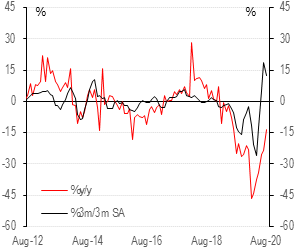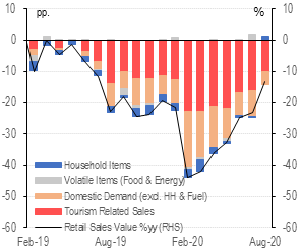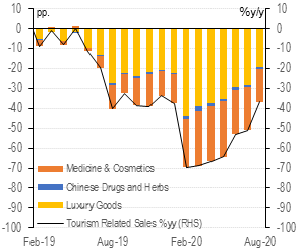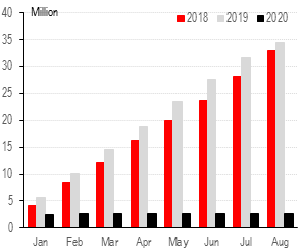 Global| Oct 01 2020
Global| Oct 01 2020Retail Sales (August 2020): Retail Sales Fall at Milder Pace in August
|in:Viewpoints
Summary
The decline in Hong Kong retail sales volume eased to -13.4% y/y in August compared to the 23.8% y/y drop in the previous month, declining for the nineteenth consecutive month. Although retail trade still suffered from double digit [...]
The decline in Hong Kong retail sales volume eased to -13.4% y/y in August compared to the 23.8% y/y drop in the previous month, declining for the nineteenth consecutive month. Although retail trade still suffered from double digit annual falls, the trend seems to be stabilising somewhat. On a 3m/3m basis, August saw an improvement of 12.3%, suggesting that the worst may be behind us (see Figure 1).
In value terms, retail sales fell by 13.1% y/y compared to -23.1% y/y the month before. The breakdown revealed that tourism related spending remained to be the largest drag on headline growth, detracting -9.9 pp. from the annual rate in August. It is interesting to see that despite the ongoing social distancing measures, a subset of discretionary spending was marginally stronger, with our proxy of household items sales adding to overall growth (0.9 pp.) for the first time since Q4’18. Our measure of household items include electrical goods, furniture and other consumer durable goods. Perhaps the helicopter money distributed by the government earlier did alleviate the dire situation in the retail trade at the margin (HK$10k was given to every Hong Kong resident as part of the government anti-pandemic stimulus). Nevertheless, with the jobs market still in moribund, overall domestic demand stayed weak, shaving almost 4 pp. from headline growth (see Figure 2).
Figure 1: The fall in retail sales volume continued in August Figure 2: Retail sales value: Contribution to annual growth (pp.)
Source: Census and Statistics Department, Haver Analytics Source: Census and Statistics Department, Haver Analytics
Taking a closer look at tourism related spending which accounts for a large chunk in total sales, the share came in at just 19.7% in August, sharply lower than the 5-year average of 31.2% prior to the Covid-19 pandemic. Indeed, border shutdown and mandatory quarantine measures had caused inbound Chinese tourist arrivals to plunge to just a total of 2.7 million since the start of the year (see Figure 4), in stark contrast to the 34.5 million witnessed over the same period last year. Figure 3 shows the composition of our tourism spending proxy, of which, sales of luxury goods (jewellery, watches and clocks and value gifts) remained a major drag on tourism related sales, followed by medicines and cosmetics. Note that sales of medicines and cosmetics could have been even weaker, were it not buoyed by local demand for PPEs against Covid-19.
Figure 3: Luxury goods is the largest drag on tourism related sales
Source: Census and Statistics Department, Haver Analytics
Figure 4: Chinese tourist arrivals have plunged since the pandemic began
Source: Hong Kong Tourism Board, Haver Analytics
However, there is one bright spot in August’s data, supermarket sales have been mostly growing at double-digit pace since January. This is because various anti-pandemic measures have led to people dinning more at home. In August, supermarket sales value grew by 13.9% y/y, slowing from 24.1% y/y a month ago.
In a nutshell, we think protracted weakness in the labour market coupled with political uncertainty will hamper retail sales growth in the near term. A potential flare up of the virus during the winter months will only increase the downside risks to both domestic and tourism demand for retail goods. The Census and Statistics Department will release GDP estimate for Q3 on 30th October. Previously, we saw a conspicuous fall in private consumption in Q2, Q3’s print is likely to remain weak but less negative. While we think the softer rate of decline in retail sales growth in recent months point to a less fragile performance in household consumption, we also think there is a new normal of shopper’s behaviour that emerged during the pandemic. This may have supported overall private consumption growth, with local spenders becoming more familiar with online shopping and struggling businesses gradually shifting to online platforms in their quest for survival.
Viewpoint commentaries are the opinions of the author and do not reflect the views of Haver Analytics.Kelvin Ho-Por Lam
AuthorMore in Author Profile »Kelvin Ho-Por Lam is a former Greater China economist with HSBC Global Markets. Before joining HSBC, he was a member of the Asia economics team at Citigroup Global Markets in Hong Kong. Prior to his return to Hong Kong in 2015, he was a UK economist at Santander in London and a property economist at MSCI Inc. In 2019, Mr. Lam was elected as a Hong Kong district councillor for the Southern district. Kelvin graduated from the University of Southampton in 2001 where he studied economics and finance. He also holds an MSc degree in economics from the University of York and an MSc in management from the London School of Economics and Political Science.






